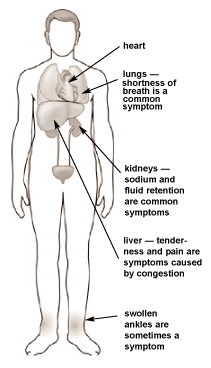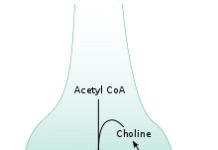Pulmonary hypertension is high blood pressure in the arteries of your lungs, as well as the arteries that carry blood from your heart to your lungs. It’s different from systemic, or regular, hypertension, which affects the arteries throughout your body, outside your heart and lungs. (1,2)
Pulmonary hypertension makes your heart work harder to pump blood through your lungs. This can trigger a number of disruptive symptoms and, eventually, can cause the right side of your heart to become enlarged and unable to adequately pump blood. Damage to your heart from pulmonary hypertension can lead to serious and even life-threatening complications. (1,2)
Signs and Symptoms of Pulmonary Hypertension
Symptoms of pulmonary hypertension typically develop slowly, over months or even years. As the disease progresses, these symptoms tend to get worse. Pulmonary hypertension symptoms can resemble those of other medical issues, which can make the condition difficult to recognize.
Pulmonary hypertension may cause these symptoms:
- Shortness of breath (at first with physical activity but then at other times as the disease progresses)
- Fatigue or weakness
- Reduced appetite
- Cough (may be dry or produce blood)
- Light-headedness, dizziness, or fainting
- Chest pain or pressure
- Swelling in the ankles, legs, or abdomen
- Racing heartbeat or heart palpitations
- Nausea, abdominal pain, or vomiting
- Hoarseness or wheezing
- Bluish color to the skin or lips (3)
How Is Pulmonary Hypertension Diagnosed?
Pulmonary hypertension can be difficult to diagnose, since its symptoms often resemble those of other conditions, and it can’t be detected in a routine physical exam alone. Your doctor will decide to perform any diagnostic tests based on your symptoms and a physical exam. (1,2)
The following tests may be used for pulmonary hypertension diagnosis:
Blood Tests These tests can help identify certain causes of pulmonary hypertension, such as an increased risk of blood clots.
Chest X-Ray This test can show enlargement of the heart or pulmonary arteries, which are signs that pulmonary hypertension may be present.
Electrocardiogram This test can identify abnormal heart rhythms that may be caused by pulmonary hypertension.
Echocardiogram This test uses sound waves to create moving images of your heart. It can be used to estimate your pulmonary blood pressure and make an initial diagnosis of pulmonary hypertension.
Cardiac Catheterization (Right Heart Catheterization) This invasive test involves inserting a thin tube into your neck or groin and threading it into your pulmonary artery, allowing your doctor to directly measure your blood pressure in the area.
Other tests may be used to assess your lung function or determine the causes of pulmonary hypertension. (1,2,3)
Types of Pulmonary Hypertension
As part of diagnosing pulmonary hypertension, your doctor will try to determine the cause of the condition. Based on these findings, your condition may be classified as being in one of five groups:
Group 1: Pulmonary Arterial Hypertension (PAH) PAH is due to problems with the structure of the pulmonary arteries and may be related to other diseases or have no known cause. It’s sometimes called primary pulmonary hypertension.
Group 2: Caused by Left-Sided Heart Disease This type of pulmonary hypertension can result from mitral valve or aortic valve disease, or long-term regular high blood pressure.
Group 3: Caused by Lung Disease This type of pulmonary hypertension can be caused by chronic obstructive pulmonary disease, obstructive sleep apnea, or other lung disorders.
Group 4: Caused by Blood Clots This type of pulmonary hypertension is typically caused by blood clots in your lungs or other clotting disorders. In chronic thromboembolic pulmonary hypertension, a rare form of the condition in this category, clots persist after three months of taking an anticoagulant.
Group 5: Caused by Other Health Conditions A wide range of other health conditions may cause or contribute to pulmonary hypertension. (2,3,4)
A severe type of pulmonary hypertension that affects newborn babies, called persistent pulmonary hypertension of the newborn (PPHN), is considered separate from each of the groups that are diagnosed in adults. PPHN is usually diagnosed within 72 hours following birth and typically requires medications and oxygen therapy to reach a stable condition. (5)
Prognosis of Pulmonary Hypertension
Whether your pulmonary hypertension gets better or worse, and how quickly, depends largely on what’s causing it and other individual factors.
There’s no direct cure for pulmonary hypertension, but in some people, the condition may be improved or resolved if it’s caused by a treatable underlying health condition.
But in other people, pulmonary hypertension gets worse over time and may lead to life-threatening complications. You may be able to improve your symptoms, and prevent or delay the worsening of pulmonary hypertension, by taking drugs or following other treatments as prescribed and making recommended lifestyle changes. (1,2,3)
RELATED: Your Definitive Guide to Heart Disease
Treatment and Medication Options for Pulmonary Hypertension
Your doctor may prescribe drugs for your pulmonary hypertension, to address any known underlying causes or to deal with its symptoms and potential complications. Pulmonary hypertension treatment may also involve lifestyle changes or other treatments to improve your heart function and physical endurance, and to improve your symptoms or prevent them from getting worse. (1,2)
Medication Options
The following drugs may be prescribed as pulmonary hypertension medications:
Vasodilators These drugs help relax blood vessels to increase blood flow in the pulmonary arteries. Vasodilators may be given by mouth or intravenously, or may be inhaled using a machine called a nebulizer.
Anticoagulants These anticlotting drugs — warfarin (Coumadin, Jantoven) is the most common — may be prescribed if your condition is caused by blood clots in your lungs or if you have risk factors for blood clots.
Digoxin (Cardoxin, Lanoxin) This drug can help strengthen your heartbeat and improve blood flow throughout your body, and may prevent some types of abnormal heart rhythms. (6)
Diuretics Also known as water pills, these drugs can help reduce fluid buildup in your body and reduce the strain this extra fluid puts on your heart.
Oxygen Using supplemental oxygen may be recommended to help you breathe if you have sleep apnea, live at a high altitude, or have severe pulmonary hypertension. (7)
Surgeries and Procedures
The following procedures may be recommended in some cases of pulmonary hypertension:
Atrial Septostomy This procedure involves creating a small hole between the right and left atria of your heart to reduce pressure on the right side and increase oxygen in your blood.
Pulmonary Angioplasty This procedure uses a balloon to help restore blood flow through your pulmonary arteries.
Pulmonary Endarterectomy This surgery removes blood clots from the blood vessels of your lungs.
Heart or Lung Transplantation A transplant may be an option for some younger people with pulmonary hypertension from unknown causes, but it carries significant risks and drawbacks. (1,2,7)
Alternative and Complementary Therapies
A number of lifestyle changes and alternative treatment programs may help you manage your pulmonary hypertension:
Have a heart-healthy diet. Reducing salt in your diet may help reduce your regular blood pressure and improve your overall heart function by reducing fluid in your body, potentially leading to some improvement of symptoms. Getting a variety of nutrients from fruits, vegetables, whole grains, and lean protein can also improve your heart health.
Engage in physical activity. Getting enough exercise, as recommended by your healthcare team, can improve your heart function. But don’t exert yourself more than is safe for your condition, and take breaks or rest when needed.
Quit smoking. If you smoke, ask your doctor about programs to help you stop.
Do a pulmonary rehabilitation program. This type of exercise and education program can help you stay physically active while experiencing less shortness of breath. It may be recommended if you have trouble with daily activities. (8)
Prevention of Pulmonary Hypertension
While preventing pulmonary hypertension isn’t always possible, your doctor may recommend certain treatments for health conditions that can lead to pulmonary hypertension as a prevention strategy. These health conditions range from blood clots to kidney disease to high blood pressure.
Routine screening tests for pulmonary hypertension are generally recommended only for people with known risk factors, such as scleroderma, a family history of the condition, or certain forms of lung or heart disease. (1)
Research and Statistics: Who Has Pulmonary Hypertension?
There are few reliable estimates of how common adult pulmonary hypertension is in the United States, in part because it’s often related to a variety of other health conditions. Group 1 PAH is considered a rare disease, with 500 to 1,000 new cases diagnosed each year, according to the American Lung Association. (10)
While pulmonary hypertension is more common with older age, it affects people of all ages. It’s more common in women, non-Hispanic black people, and people over age 75 than in other groups in the United States. (11)
Worldwide, the incidence of pulmonary hypertension appears to be growing, according to a study published in February 2018 in the journal Circulation: Cardiovascular Quality and Outcomes. From 1993 to 2012, the number of people living with condition each year went from 99.8 to 127.3 per 100,000 people. The most common type of pulmonary hypertension is group 2 (caused by left-sided heart disease), making up 34.2 percent of cases, with an overlap of group 3 (caused by lung disease) that also meets criteria for group 2 making up another 29.3 percent. (12)
Resources We Love
Living with pulmonary hypertension can be scary and challenging, but there are websites and organizations that can help you find the information and support you need. Here are some of the best resources we’ve found.
- The Pulmonary Hypertension Association
- Pulmonary Hypertension webpage from the National Heart, Lung, and Blood Institute
- Pulmonary Hypertension webpage from the American Heart Association
- Pulmonary Hypertension webpage from the Mayo Clinic


Editorial Sources and Fact-Checking
- Pulmonary Hypertension. National Heart, Lung, and Blood Institute.
- Pulmonary Hypertension. Mayo Clinic. March 20, 2020.
- Pulmonary Hypertension — High Blood Pressure in the Heart-to-Lung System. American Heart Association. October 31, 2016.
- Chronic Thromboembolic Pulmonary Hypertension (CTEPH). Cleveland Clinic. October 17, 2019.
- Persistent Pulmonary Hypertension of the Newborn (PPHN). Nationwide Children’s.
- Patel R, Aronow W, Patel L, et al.Treatment of Pulmonary Hypertension. Medical Science Monitor: International Medical Journal of Experimental and Clinical Research. 2012.
- Treatments. Pulmonary Hypertension Association.
- The Basics of Pulmonary Rehabilitation. American Lung Association. February 19, 2020.
- COVID-19 and Pulmonary Hypertension. Pulmonary Hypertension Association.
- Learn About Pulmonary Arterial Hypertension. American Lung Association. April 28, 2020.
- Pulmonary Hypertension. Centers for Disease Control and Prevention. December 3, 2019.
- Wijeratne D, Lajkosz K, Brogly S, et al. Increasing Incidence and Prevalence of World Health Organization Groups 1 to 4 Pulmonary Hypertension. Circulation: Cardiovascular Quality and Outcomes. February 2018.











































